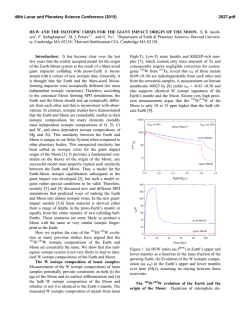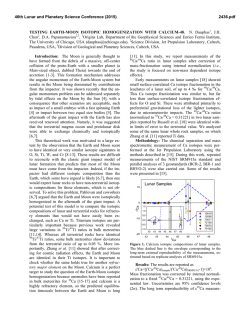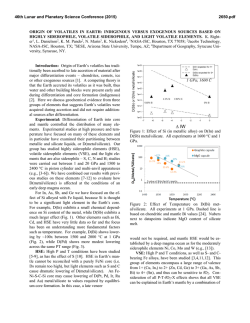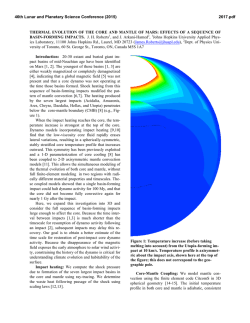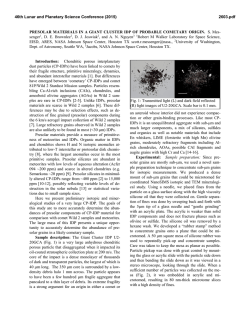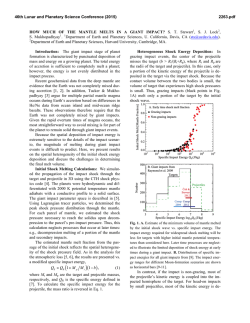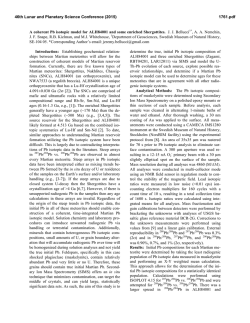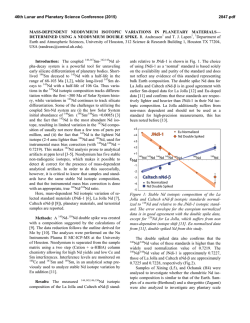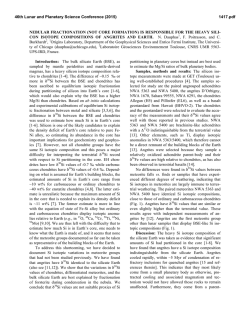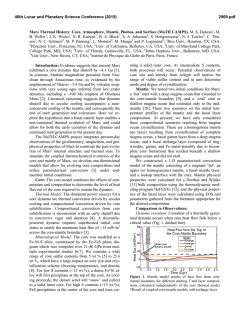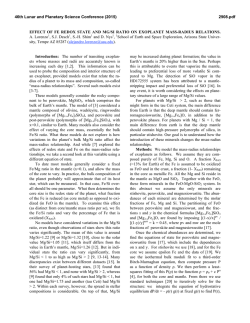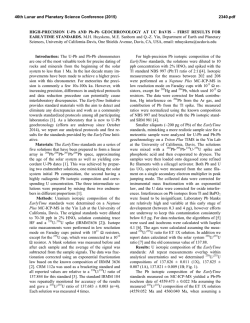
TUNGSTEN ISOTOPE CONSTRAINTS ON BIG EVENTS IN EARTH
46th Lunar and Planetary Science Conference (2015) 1857.pdf TUNGSTEN ISOTOPE CONSTRAINTS ON BIG EVENTS IN EARTH-MOON HISTORY: CURRENT INSIGHTS AND LIMITATIONS. R.J. Walker1, M. Touboul2, I.S. Puchtel1 and, 1Department of Geology, University of Maryland, MD 20742, USA ([email protected]), Laboratoire de Geologie de Lyon Ecole Normale Supérieure de Lyon, 69364 Lyon Cedex 07, France. The short-lived 182Hf-182W isotopic system (182Hf → W + -; t½ = 8.9 Myr) has proved useful in constraining the timing of metal-silicate segregation in small through large bodies, including Earth [1-3]. Silicate fractionation processes can lead to major modifications in Hf/W, so the system also has potential utility for constraining the timing of magma ocean processes and subsequent mantle mixing rates [4-5]. Discovery of small enrichments and depletions in 182 W/184W in some Archean rocks (spanning >25 ppm variation), relative to the modern terrestrial mantle [68], suggests possible exogeneous and endogenous modifications to highly siderophile element (HSE) and moderately siderophile element (MSE) abundances in Earth’s mantle (Fig. 1). An exogenous process that would lead to W isotopic variability in the mantle is heterogeneous late accretion, whereby diverse late accreted materials remained unevenly mixed within the mantle for hundreds of millions of years subsequent to planetary formation. Those mantle domains that initially received little of the late accretionary component would be enriched in 182W by approximately the magnitude observed in some early Earth rocks [6]. No 182 W-enriched lithologies examined to date, however, show strong evidence for derivation from HSEdepleted mantle, as required for this model. Endogenous processes could include magma ocean crystallization and overturn, while 182Hf was still extant [4,7]. No evidence for coupling of the 182Hf-182W and 146Sm142 Nd short-lived systems, as would be predicted for magma ocean scenarios, however, has yet been firmly established. Due to the lack of strong complementary evidence for either exogenous or endogenous processes, the cause(s) of the heterogeneities remain cryptic. Regardless of the exact processes involved, collectively the W isotopic enrichments and depletions in terrestrial rocks indicate the early formation of chemically fractionated reservoirs in the mantle that, in some instances, almost certainly formed prior to, then survived the putative Moon-forming giant impact. Thus, it can be concluded that the impact did not lead to wholesale mixing of the silicate Earth, and some primordial mantle domains, perhaps at the core-mantle boundary, remained intact throughout the event. In addition to terrestrial heterogeneities, recent, highly-precise measurements of the 182W/184W of lunar rocks indicate that at least some portions of the silicate 182 Moon are ~20 ppm more radiogenic than the modern terrestrial mantle [9-10] (Fig. 1). The difference could reflect incorporation of a slightly higher proportion of (more radiogenic) W derived from the giant impactor into the coalescing Moon, as has also been suggested to be responsible for the slightly heavier 17O of the Moon [11]. It is also possible that the offset reflects minor ingrowth of excess 182W in the Moon, due to a higher Hf/W for the bulk silicate Moon or a portion of the lunar mantle, compared to the bulk silicate Earth. Such an explanation would require that the Moon formed while 182Hf was still extant, within ~60 Ma of Solar System formation. Although these options cannot yet be ruled out, the W isotopic disparity between the silicate Earth and Moon perfectly matches the predicted isotopic offset that would result from disproportional late accretion to the two bodies [12]. Consequently, we favor this interpretation to explain the difference. Disporportional late accretion to the Earth and Moon is evidenced by the ~20X higher abundances of HSE in the terrestrial mantle compared to the lunar mantle, as determined from measurements of lunar volcanic glasses and basalts [13-14]. The difference in the HSE abundances present in the mantles of the two bodies has been previously ascribed to stochastic late accretionary processes [15]. If the W isotopic difference between the Moon and Earth really is the result of disproportional addition of late accreted materials to the mantles of the Earth and the Moon, then the results provide some important additional constraints on the nature of late accretion, as well as on the putative giant impact that generated the Moon. First, this interpretation requires the assumption that, at the time of Moon formation, the Earth and Moon had the same W isotopic composition. This requirement follows other evidence for isotopic similarity between the Moon and Earth in elements such as O, Ti and Cr. One possible cause for this isotopic match is that the giant impactor happened to have been built from very similar building blocks as the Earth, coincidentally winding up with essentially the same isotopic compositions for elements that show genetic variability in their isotopic compositions [e.g., 16]. The W isotopic composition of the silicate portion of the impactor, however, was an outcome of radiogenic decay of 182 Hf, coupled with the Hf/W history of its mantle. Consequently, it is very unlikely that the impactor 46th Lunar and Planetary Science Conference (2015) would have evolved to the same W isotopic composition as Earth at the time of the impact, regardless of its genetic make-up. Thus, an interpretation of disproportional late accretion greatly favors giant impact scenarios that seek to explain the isotopic similarities between the Moon and Earth as either a result of high temperature equilibration processes [17], or creation of the Moon from materials mainly derived from the proto-Earth [18], rather than a result of accretionary happenstance. A second requirement for an interpretation of disproportional late accretion is that the late accretionary accumulation clocks for the Moon and Earth began at the time as the giant impact. Thus, the giant impact was a clearinghouse event for HSE that were present in the terrestrial mantle prior to the impact. This means that at least some of the metal from the core of the impactor efficiently extracted the HSE from the silicate Earth while transiting the mantle to merge with Earth’s core. Some aspects regarding the nature of siderophile elements during the giant impact remain poorly understood. For example, it remains unknown whether the W isotopic composition of Earth’s mantle prior to the giant impact was more or less radiogenic than the bulk silicate Earth today. This has great bearing on the intepretation of the average age of core formation for the Earth. In the event of major equilibration between the metal of the impactor core and the silicate Earth, the W isotopic composition of the silicate Earth could have been as much as 200 ppm more radiogenic than the present isotopic composition. By contrast, if there was little equilibration between impactor metal and the silicate Earth, the mantle might have been as much as 100 ppm less radiogenic than the present mantle. This is because the silicate portion of the impactor could have added as much as 10% of the W budget of the mantle in the form of much more radiogenic W. Our present lack of knowledge regarding the rates of elemental and isotopic equilibration between metal and silicate for highly and moderately siderophile elements is a major limitation to deciphering the above issue. For example, it has been shown for Os (a HSE) that elemental equilibration occurs much more rapidly than isotopic equilibration [19]. If this were also true for the moderately siderophile W, it is possible that the Earth’s mantle could have achieved elemental equilibration with metal from the giant impactor, but leaving little effect on the isotopic composition of W in the mantle, regardless of process. It also remains unknown how much metal must be processed through a mantlesize volume in order to efficiently remove HSE, as required by the scenario outlined above. Experiments that involve the incorporation of isotopic tracers are 1857.pdf needed to better understand the nature of elemental verus isotopic equilibration in metal-silicate systems. References: [1] Yin Q-Z. et al. (2002) Nature 418, 949-952. [2] Dauphas N. & Pourmand A. (2011) Nature 473, 489-492. [3] Kruijer T. et al. (2014) Science 344, 1150-1154. [4] Righter K. & Shearer C.K. (2003) GCA 67, 2497-2507. [5] Brown S. et al. (2014) EPSL 408, 319-330. [6] Willbold M. et al. (2011) Nature 477, 195-198. [7] Touboul M. et al. (2012) Science 335, 1065-1069. [8] Touboul M. et al. (2014) Chem. Geol. 383, 63-75. [9] Kleine T. et al. (2014) LPSC 45, 2895. [10] Touboul et al. (2015) Nature, in revision. [11] Herwartz D. et al. (2014) Science 344, 11461150. [12] Walker R.J. (2014) Phil. Trans. Roy. Soc. A 372, 20130258. [13] Walker R.J. et al. (2004) EPSL 224, 399-413. [14] Day J.M.D. et al. (2007) Science 315, 217-219. [15] Bottke W.F. et al. (2010) Science 330, 1527-1530. [16] Dauphas N. et al. (2014) Phil. Trans. R. Soc. A. 372, 20130244. [17] Pahlevan K. & Stevenson D.J. (2007) EPSL 262, 438-449. [18] Ćuk M. & Stewart S.T. (2012) Science 338, 1047‐1052. [19] Yokoyama T. et al. (2009) EPSL 279, 165–173. Figure 1. Tungsten isotopic data (in ppm deviation from modern terrestrial standards) for terrestrial komatiites through time compared with data for metal separates from Apollo 16 impact melt rocks [10].
© Copyright 2026
